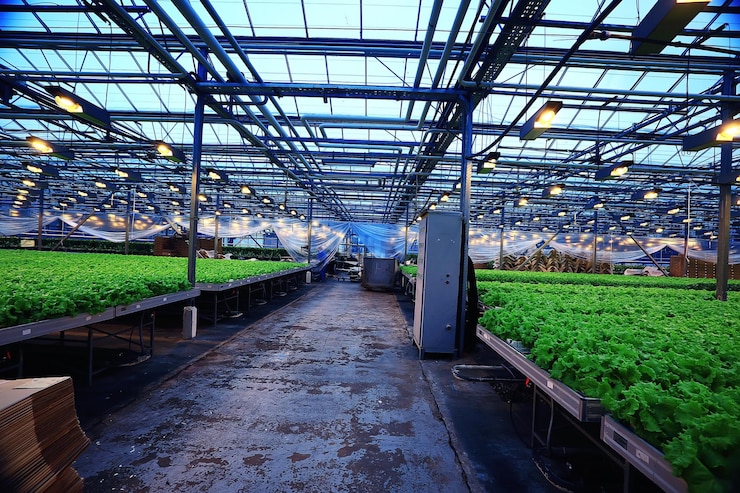In the vast tapestry of agriculture, there exists a realm where farming exceeds the unusual fields and local markets. It’s a world where agriculture becomes a thriving business, a powerhouse of economic activity, and a lifeline for nations. This domain is none other than Commercial Agriculture. In this guide, we’ll talk about it, exploring its definition, significance, methods, challenges, and impact on our lives.

Commercial agriculture is the intentional and systematic cultivation of crops and livestock with the primary objective of generating profit. Unlike subsistence farming, which focuses on feeding one’s family or community, commercial agriculture is a business venture. It’s a world where fields become factories, and every crop or livestock is a commodity to be bought and sold.
So, what sets commercial agriculture apart from traditional farming? Let’s dig deeper.
Characteristics of Commercial Agriculture
Commercial agriculture is characterized by several key features that distinguish it from other forms of farming. Understanding these characteristics is crucial to grasp the essence of this agricultural paradigm.
Scale and Scope
One defining aspect of commercial agriculture is its scale. It operates on a large scale, with vast expanses of land dedicated to single or multiple crops. This scale allows for efficiency, mechanization, and a higher yield per acre.
Profit-Driven
In commercial agriculture, profit is the North Star (company’s unwavering definition of its purpose, products, customers, and potential acquirers). Every decision, from crop selection to harvesting techniques, is made to maximize revenue. It threatens contrasts with reality of farming, where the goal is mere survival.
Market Orientation
Commercial agriculture is intimately tied to the market. Farmers in this sector grow crops and raise livestock based on market demand. They keep a watchful eye on prices, consumer trends, and global markets to make informed decisions.
Advanced Technology
To enhance productivity and efficiency, commercial agriculture embraces cutting-edge technology. Technology, from tractors and drones to genetically modified crops, is pivotal in this sector.
Specialization
Specialization is a cornerstone of commercial agriculture. Farms often focus on a specific crop or livestock type in which they have a competitive advantage. This specialization allows for expertise and efficiency.
Capital Intensive
The machinery, infrastructure, and inputs required for commercial agriculture demand substantial capital investment. This aspect can be a barrier to entry for smaller farmers.
Global Perspective
Commercial agriculture operates in a globalized world. It’s not confined to local markets; products may be exported internationally. This global perspective means that events on the other side can impact local farming decisions.
Risk Management
Commercial agriculture involves careful risk management. Farmers may use tools like crop insurance to protect against unpredictable weather disasters or market fluctuations.
Sustainability Concerns
In recent years, sustainability has become a pressing concern in commercial agriculture. Balancing profitability with environmental stewardship is a challenge many farmers are addressing.
With these characteristics in mind, it’s clear that commercial agriculture is a multifaceted and dynamic sector. But what drives individuals to engage in this complex endeavor? Let’s explore the motivations behind commercial farming.
Why Engage in Commercial Agriculture?
Profit Potential
At the core of commercial agriculture is the lure (as in to tempt) of profit. Unlike subsistence farming, where the focus is on survival, commercial farming offers the potential for significant financial gain.
Economic Stability
Commercial agriculture can provide economic stability for farming communities and entire regions. It creates jobs, generates income, and contributes to a stable local economy.
Technological Innovation
Commercial agriculture is a playground for those passionate about cutting-edge technology and innovation. It’s a sector where science and agriculture intersect, leading to advancements that benefit us all.
Feeding the World
Commercial agriculture plays a vital role in feeding the world’s growing population. Innovations in crop production and distribution contribute to global food security.
Lifestyle Choice
For some, commercial agriculture is a way of life—a calling to work the land, nurture crops, and raise livestock. It’s a lifestyle choice connecting them to the earth profoundly.
Environmental Stewardship
While profit is a driving force, many commercial farmers are increasingly conscious of their environmental impact. They seek sustainable practices that preserve the land for future generations.
Why is Commercial Agriculture Important?
The importance of commercial agriculture cannot be overstated. It is pivotal in providing food security, generating income, and fostering rural development. Let’s delve deeper into the significance of this practice:
Global Food Production
Commercial agriculture is the engine behind most of the world’s food supply. From grains to fruits and vegetables, it ensures a steady and abundant food source for local and international markets.
Economic Growth
It serves as a driving force for economic growth. Large-scale farming operations create job opportunities, stimulate the agro-industrial sector, and contribute significantly to a country’s Gross Domestic Product (GDP).
Technology Advancements

Commercial agriculture is at the forefront of technological innovations. Precision farming techniques, advanced machinery, and genetic modifications have revolutionized the industry, enhancing productivity and efficiency.
Trade and Export
Many nations rely on commercial agriculture to export products, earning foreign exchange and strengthening trade relationships. Products like coffee, cocoa, and soybeans are essential exports for many countries.
Rural Development
Commercial agriculture often serves as the lifeblood of rural communities. It fosters infrastructure development, including roads and schools, improving the quality of life for rural residents.
Methods of Commercial Agriculture
In the realm of commercial agriculture, precision and scale are paramount. Farmers employ modern techniques and technologies to optimize production. These methods include:
- Mechanization: The clanking of tractors and the hum of combines are the symphony of modern commercial agriculture. Mechanization has revolutionized farming, increasing efficiency and output.
- Crop Rotation: A well-thought-out dance of crops on the same land, crop rotation minimizes soil degradation and maximizes yield.
- Use of Pesticides and Fertilizers: To combat pests and enhance soil fertility, commercial agriculture relies on carefully selected chemicals.
- Genetically Modified Organisms (GMOs): These crops have been genetically engineered to resist pests, diseases, and environmental stress, contributing to higher yields.
- Irrigation Systems: Reliable water supply through advanced irrigation systems ensures consistent crop growth.
- Large-Scale Livestock Operations: Commercial agriculture extends to livestock, where massive facilities are dedicated to meat, dairy, and poultry production.
Challenges of Commercial Agriculture
The path to profit in commercial agriculture is not without hurdles:
Market Volatility
The prices of agricultural commodities are notoriously volatile. Weather, global trade policies, and supply chain disruptions can lead to sudden price fluctuations, impacting farmers’ income.
Resource Intensiveness
Commercial agriculture consumes vast resources, particularly water and energy. Managing these resources sustainably becomes an urgent challenge as the global population swells.
Environmental Sustainability
Balancing productivity with environmental conservation is a tightrope walk. Practices like monoculture and excessive chemical use can harm ecosystems. Adopting eco-friendly methods is an ongoing struggle.
Land Use Pressure
The ever-expanding urban sprawl encroaches on fertile lands, reducing the available space for agriculture. This competition for land intensifies the challenge of feeding a growing population.
Labor Issues
Modern commercial agriculture often relies on seasonal labor, leading to concerns about fair wages and working conditions for farm workers.
Impact on Our Lives
Commercial agriculture touches us in ways we might not always realize. It shapes our diets, our economies, and even our cultural identities. Think about your last meal—chances are it included ingredients from commercial agriculture. Its influence is pervasive from that morning cup of coffee to the evening’s dinner.
In conclusion, commercial agriculture, often called agribusiness, is a multifaceted endeavor driven by profit. It distinguishes itself from subsistence farming by operating on a large scale and aiming to maximize revenue. This sector is characterized by its market orientation, reliance on advanced technology, specialization, and the need for substantial capital investment. While it faces challenges like market volatility, resource intensiveness, and environmental sustainability, its significance cannot be understated. Commercial agriculture is pivotal in global food production, economic growth, technological innovation, and rural development. It shapes the way we eat, the economies of nations, and the future of farming. Balancing profitability with sustainable practices is crucial as we move forward to ensure a thriving and environmentally conscious agricultural industry.
